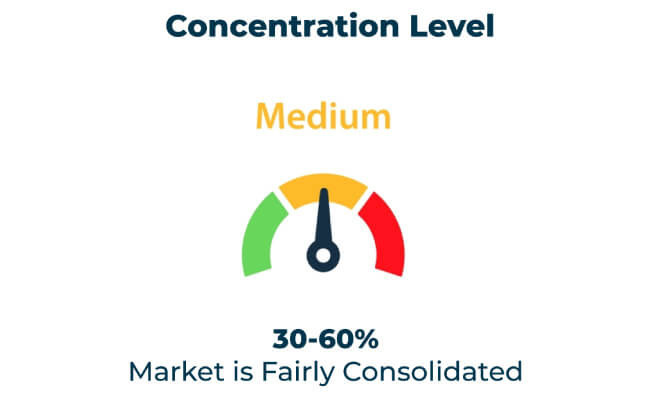The tube and core market is evolving rapidly as industries demand sustainable, durable, and high-performing solutions for winding, storage, and transport. Manufacturers are innovating with recyclable materials, lightweight designs, and eco-friendly production methods to meet the needs of sectors like textiles, paper, packaging, and construction. By 2035, the global tube and core market is projected to exceed USD 6.2 billion, growing at a compound annual growth rate (CAGR) of 5%.
The shift toward circular economy practices and increasing adoption of eco-friendly alternatives drive market growth. Companies focus on delivering customizable and high-strength products that meet the requirements of modern manufacturing and logistics systems.
| Attributes | Description |
|---|---|
| Projected Market Value (2035) | USD 6.2 billion |
| Value-based CAGR (2025 to 2035) | 5% |
Factors Driving Market Growth
Global Market Share & Industry Share
| Category | Market Share (%) |
| Top 3 Players (Sonoco, Greif, Smurfit Kappa) | 17% |
| Rest of Top 5 Players (Caraustar, Papertech) | 09% |
| Next 5 of Top 10 Players | 06% |
Type of Player & Industry Share
| Type of Player | Market Share (%) |
| Top 10 Players | 32% |
| Next 20 Players | 38% |
| Remaining Players | 30% |

Year-on-Year Leaders
Emerging markets in Asia-Pacific, Africa, and Latin America offer significant growth potential. Increasing industrialization, along with rising awareness of sustainable practices, drives demand for recyclable and durable tube and core solutions. Exporters can tap into these regions by aligning with local standards and industry preferences.
In-House vs. Contract Manufacturing
| Region | North America |
|---|---|
| Market Share (%) | 30% |
| Key Drivers | Sustainability and industrial demand fuel market growth. |
| Region | Europe |
|---|---|
| Market Share (%) | 35% |
| Key Drivers | Recycling infrastructure and green policies drive demand. |
| Region | Asia-Pacific |
|---|---|
| Market Share (%) | 25% |
| Key Drivers | Rising industrialization and eco-friendly initiatives grow the market. |
| Region | Other Regions |
|---|---|
| Market Share (%) | 10% |
| Key Drivers | Affordable, durable solutions gain traction in emerging markets. |
The tube and core market will grow through advancements in eco-friendly materials, automation, and lightweight designs. Companies that prioritize customization, sustainability, and partnerships with industrial clients will lead the industry. Emerging markets and global trade opportunities will drive additional growth.
| Tier | Key Companies |
|---|---|
| Tier 1 | Sonoco, Greif, Smurfit Kappa |
| Tier 2 | Caraustar, Papertech |
| Tier 3 | Ox Industries, Mondi Group |
The tube and core market is set for sustained growth as sustainability, customization, and industrial innovation drive demand. Companies that invest in eco-friendly practices, automation, and emerging markets will lead the way. Collaboration with industry partners and advancements in recycling technologies will further enhance the market’s prospects.
Key Definitions
Abbreviations
Methodology
This report integrates primary research, secondary data, and expert insights. Analysts validated findings through interviews with industry professionals and end-users to ensure actionable and reliable insights.
Market Definition
The tube and core market includes the development, production, and use of durable, sustainable solutions for industries like textiles, paper, packaging, and construction. These products emphasize performance, recyclability, and cost efficiency.
Tubes and cores are primarily used in industries like paper, packaging, textiles, and construction to support, protect, or transport materials like rolls, yarns, and structural components.
Most tubes and cores are made from paperboard, recycled paper, or plastic. Recently, there’s been a shift toward biodegradable and fully recyclable materials.
Manufacturers are focusing on using recyclable materials, reducing carbon emissions through energy-efficient production processes, and minimizing waste with optimized designs.
Key industries include paper and packaging, textiles, construction, and e-commerce. The rise of online shopping has significantly boosted demand for protective cores.
Asia-Pacific, Africa, and Latin America are emerging as high-growth regions due to expanding industries and increasing demand for cost-effective, eco-friendly solutions.






Full Research Suite comprises of:
Market outlook & trends analysis
Interviews & case studies
Strategic recommendations
Vendor profiles & capabilities analysis
5-year forecasts
8 regions and 60+ country-level data splits
Market segment data splits
12 months of continuous data updates
DELIVERED AS:
PDF EXCEL ONLINE
Tube Tester Market Size and Share Forecast Outlook 2025 to 2035
Tube Rotator Market Size and Share Forecast Outlook 2025 to 2035
Tuberculosis Therapeutics Market Size and Share Forecast Outlook 2025 to 2035
Tube Laminating Films Market Size and Share Forecast Outlook 2025 to 2035
Tube Filling Machine Market Size and Share Forecast Outlook 2025 to 2035
Tube Ice Machine Market Size and Share Forecast Outlook 2025 to 2035
Tube Closures Market Size and Share Forecast Outlook 2025 to 2035
Tube Sealing Machines Market Analysis by Tube type, Technology type, End User, and Region through 2025 to 2035
Tuberculous Meningitis Treatment Market - Demand & Innovations 2025 to 2035
Tube Feeding Formula Market Analysis by Product Type, Form, End User, Primary Condition and Distribution Channel Through 2035
Tuberculosis Diagnostics Market
Market Share Distribution Among Tube Filling Machine Manufacturers
Competitive Breakdown of Tube Sealing Machines Providers
Breaking Down Market Share in Tube Laminating Films
Tube and Dressing Securement Products Market
Tube and Core Market Size and Share Forecast Outlook 2025 to 2035
Tubes, Bottles and Tottles Market
U-Tube Viscometer Market Size and Share Forecast Outlook 2025 to 2035
Nontuberculous Mycobacterium Treatment Market
LED Tube Market Size and Share Forecast Outlook 2025 to 2035

Thank you!
You will receive an email from our Business Development Manager. Please be sure to check your SPAM/JUNK folder too.
Chat With
MaRIA